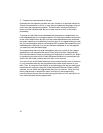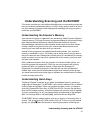23
Understanding Scanning and the BCD996T
even interfere with each other to the point where it is impossible to clearly receive
any of the stations. A scanner, such as your BCD996T, equipped with CTCSS and
DCS, can code each received frequency with a specific sub-audible CTCSS or
DCS frequency or code. Then, when you receive multiple signals, you only hear
the transmission with the CTCSS or DCS tone you programmed. If you do not
receive the correct tone with a signal, the scanner’s squelch remains closed and
you hear nothing.
The tables showing the available CTCSS frequencies and DCS codes are found in
the Reference Section of this manual.
Conventional Scanning
Conventional scanning is a relatively simple concept. Each group of users in a
conventional system is assigned a single frequency (for simplex systems) or two
frequencies (for repeater systems). Any time one of them transmits, their
transmission always goes out on the same frequency. Up until the late 1980s, this
was the primary way that radio systems operated.
Even today, there are many 2-way radio users who operate using a conventional
system:
• Aircraft
• Amateur radio
• FRS/GMRS users
• Broadcast AM/FM/TV stations
• Many business radio users
When you want to store a conventional system, all you need to know are the
frequencies they operate on. When you are scanning a conventional system, the
scanner stops very briefly on each channel to see if there is activity. If there isn’t,
the scanner quickly moves to the next channel. If there is, then the scanner pauses
on the transmission until it is over.
Simplex Operation
Simplex systems use a single frequency for both transmit and receive. Most radios
using this type of operation are limited to line-of-sight operation. This type of radio
is frequently used at construction job sites, and with inexpensive consumer radios
such as GMRS/FRS radios. The range is typically 1-15 miles, depending upon the
terrain and many other factors.


















